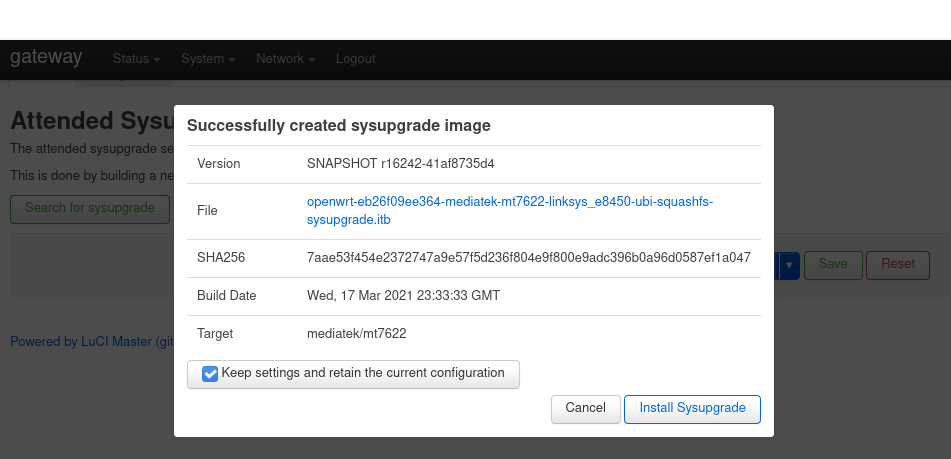This project intends to simplify the sysupgrade process of devices running
OpenWrt or distributions based on the former like LibreMesh. The provided tools
here offer an easy way to reflash the router with a new version or package
upgrades, without the need of opkg installed.
Additionally it offers an API (covered below) to request custom images with any selection of packages pre-installed, allowing to create firmware images without the need of setting up a build environment, even from mobile devices.
Simple web interface using vanilla JavaScript currently developed by @mwarning. It offers a device search based on model names and show links either to official images or requests images via the asu API. Please join in the development at the GitLab repository
The package
luci-app-attendedsysupgrade
offers a simple view under System > Attended Sysupgrade to automatically
request a new firmware, wait until it's built and flash it.
It's possible to upgrade routers via a command line interface called
auc.
The server listens to image requests and automatically generate them if the request was valid. This is done by automatically setting up OpenWrt ImageBuilders and cache images in a Redis database. This allows to quickly respond to requests without rebuilding existing images again.
- asu.aparcar.org
chef.libremesh.org(This domain will be shortly forewarded to the new server.
Redis is required to store image requests:
sudo apt install redis-server tar
Install asu:
pip install asu
Start the server via the following commands:
export FLASK_APP=asu.asu # set Flask app to asu
flask janitor update # download upstream profiles/packages
flask run # run development server
Start the worker via the following comand:
rq worker
Run The service inside multiple Docker containers. The services include the
ASU server itself, a janitor service which fills the Redis database with
known packages and profiles as well as a rqworker which actually builds
images.
Currently all services share the same folder and therefore a very "open" access is required, suggestions on how to improve this setup are welcome.
mkdir ./asu-service/
chmod 777 ./asu-service/
docker-compose up
A webserver should proxy API calls to port 8000 of the server service while
the asu/ folder should be file hosted as is.
It is recommended to run ASU via gunicorn proxied by nginx or
caddyserver. Find a possible server configurations in the misc/ folder.
The ASU server will try $PWD/config.py and /etc/asu/config.py to find a
configuration. Find an example configuration in the misc/ folder.
pip install gunicorn
gunicorn "asu.asu:create_app()"
Ideally use the tool squid to cache package indexes, which are reloaded every
time an image is build. Find a basic configuration in at misc/squid.conf
which should be copied to /etc/squid/squid.conf.
If you want to use systemd find the service files asu.service and
rqworker.service in the misc folder as well.
After cloning this repository create a Python virtual environment and install the dependencies:
python3 -m venv .direnv
source .direnv/bin/activate
pip install -r requirements.txt
export FLASK_APP=asu.asu # set Flask app to asu
export FLASK_DEBUG=1 # run Flask in debug mode (autoreload)
flask run
The API is documented via OpenAPI and can be viewed interactively on the server:



